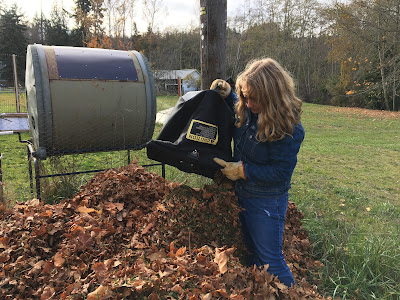Over the weekend, my husband found a great deal on a zero-turn Kubota mower with a two-bin bagger, and due to the amount of yard that we need to mow and the fact that our old mower keeps breaking down, we decided to make the purchase. Now, you can imagine my husband's excitement over the fast and powerful mower -- at one point I heard him make a Tim the Tool Man style grunt as he quickly spun the mower around 180 degrees right in front of me and then sped back across our leaf-covered yard.
Meanwhile, I was excitedly helping empty into the growing mulch pile the many bins of shredded leaves he had collected with the new mower. Garden mulch! I was giddy with joy as I realized what this will mean for next year's garden.
After a while, my daughter joined the effort to empty the bins, making quick work of building up an enormous pile. The shredded leaves will break down more quickly and by next spring we should have what is known as leaf mold to put on the garden.
If you enjoy gardening, you likely know how costly mulch can be if you have to purchase it. In years past, I've had to purchase bales of straw to use as mulch, and I've never felt comfortable spending as much as I would need to in order to cover all the areas of the garden. I'm so excited that this year's mulch will come from the leaves we gathered. Why? Below are the 5 benefits of leaf mold as a soil amendment that I'm looking forward to in next year's garden:
- Leaf mold retains moisture in the soil. We live in an area that gets very little rain over the summer months, and since our water source is city water, reducing the amount of water I'll need to put on the garden will be a cost savings.
- Leaf mold improves the soil's structure. We have an area in the garden where the soil is dry and powdery; this section dries out too quickly and has fewer nutrients, which we found hampered the growth of the vegetables we planted there this past summer. I'm looking forward to using both compost and leaf mold to improve the soil in this area.
- Leaf mold acts as a weed barrier. I plan to add as much as 6 inches of leaf mold along the pathways and right up to the base of the plants to help keep the soil loose (so it's easier to pull any weeds that do take hold) and to act as a barrier over the soil.
- Leaf mold contains trace elements and beneficial microbes that gardens need to produce higher yields. Nutrients from leaf mold that become available to garden plants as the mulch continues to break down over time include nitrogen, phosphorus, potassium, calcium, magnesium, sulfur, boron, iron, manganese, chloride, sodium, copper, and zinc. By using leaf mold, we should be able to reduce the amount of organic soil amendments that we purchase.
- Leaf mold provides a habitat for beneficial bacteria and earthworms. Leaf mold acts as a soil conditioner, providing an ideal habitat for soil organisms that in turn add to the nutrient content and soil aeration that garden plants thrive on.
While it's not necessary to chop or shred leaves before putting them into a pile, doing so helps the leaves break down more quickly so that they can be added to the garden sooner. We should be able to use the mowed-over leaves we gathered this weekend in next spring's garden.






Comments
Post a Comment
Thank you so much for submitting a comment! All comments are reviewed by our moderator before being posted to the blog, in an effort to help control spam.